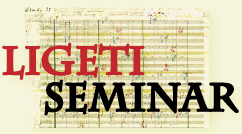3) The Sixties; Darmstadt / Fluxus
Relations to colleagues, emphasis on the voice and theater (Aventures and Nouvelles Aventures, the Requiem and Lux Aeterna), Cello Concerto as “anti” concerto.
For week 4
Read
Paul Griffiths, Music Theatre , Modern Music and After (Oxford: Oxford University Press, 2010)
Richard Toop, "Expanding horizons: the international avant-garde, 1962–75," in The Cambridge history of twentieth-century music, Nicholas Cook and Anthony Pople (eds) (Cambridge: Cambridge University Press, 2004)>
Louise Duschesneau, "… Music is a bit like live – you do it, but you don’t talk about it,” György Ligeti's Cultural Identities Amy Bauer and Márton Kerékfy, eds., (London, NY: Routledge, 2017), 39–50. On reserve LL
Ove Nordwall, "György Ligeti," Tempo 88 (Spring 1969), 22-25.
György Ligeti with Hans Heinz Stuckenschmidt, "Music in the Technological Era," (1963), translated and annotated by Louise Duchesneau, in György Ligeti's Cultural Identities, AmyBauer and Márton Kerékfy, eds. (London, NY: Routledge, 2017), 21–38.
Amy Bauer, Transparent Tangle of History (Lontano, Chapter 4), Ligeti’s Laments: Nostalgia, Exoticism and the Absolute (Aldershot, UK: Ashgate), 2011.
György Ligeti, “Metamorphoses of Musical Form,” Tr. Cornelius Cardew, Die Reihe 7: Form-Space (Bryn Mawr: Theodore Presser Co., 1965), 5-19.
Listen
Further Reading
György Ligeti and Josef Hausler, "Ligeti — Josef Hausler (1969)," in Ligeti in Conversation with Péter Várnai, Josef Häusler, Claude Samuel and Himself, trans. Sarah E. Soulsby (London: Eulenburg, 1983) 83–110.
Amy Bauer, Lament as Universal Exception (Chapter 3), Ligeti’s Laments: Nostalgia, Exoticism and the Absolute (Aldershot, UK: Ashgate), 2011.
Stefan Beyst, Aventures: Ode to the discrepancy between word and deed (January 2003)
Hans Keller, "The Contemporary Problem," Tempo 89 (Summer, 1969), 25, 27-28.
Janet Owen Thomas, "Ligeti's Organ Music," The Musical Times 124:1683 (1983), 319–21.
Amy Bauer, "Genre as émigré: the return of the repressed in Ligeti’s Second Quartet," György Ligeti's Cultural Identities, Amy Bauer and Márton Kerékfy, eds. London, NY: Routledge 2017 181–202.
Jane Piper Clendinning, “The Pattern-Meccanico Compositions of György Ligeti,” Perspectives of New Music 31/1 (1993), 192-234, and “Structural Factors in the Microcanonic Compositions of György Ligeti,” in Concert Music, Rock, and Jazz Since 1945, edit. Elizabeth West Marvin and Richard Hermann (Rochester: University of Rochester Press, 2002), 229-56.
Michael Hicks, “Interval and Form in Ligeti’s Continuum and Coulée,” Perspectives of New Music 31/1 (1993), 172-90.
Benjamin R. Levy, "Shades of the Studio: Electronic Influences on Ligeti’s Apparitions," Perspectives of New Music 47/2 (2009), 59–87.
Charles D. Morrison, “Stepwise Continuity as a Structural Determinant in György Ligeti’s 10 Pieces for Wind Quintet,” Perspectives of New Music 24/1 (1985), 158-82.
Bruce Reiprich, “Transformation of Coloration and Density in György Ligeti’s Lontano,” Perspectives of New Music 16/2 (1978), 167-80.
Miguel A. Roig-Francoli, “Harmonic and Formal Processes in Ligeti’s Net-Structure Compositions,” Music Theory Spectrum 17/2 (Fall, 1995), 242-67.
Michael D. Searby, “Ligeti’s Chamber Concerto – Summation or Turning Point?,” Tempo 168 (Mar 1989), 30-34.
Work List
Trois Bagatelles for David Tudor (1961) LL
Fragment for chamber orchestra (1961)
Poème symphonique for 100 metronomes (1962)
Aventures for three singers and seven instrumentalists (1962)
Nouvelles Aventures for three singers and seven instrumentalists (1962-65)
I. Sostenuto
II. Agitato molto
Requiem (1963-65) LL
Introit
Kyrie
Die judicii sequentia
Lacrymosa
Lux Aeterna for 16 voices (1966) LL
Concerto for Violincello (1966) LL
I. 6'55"
II. 7'27"
 print
print